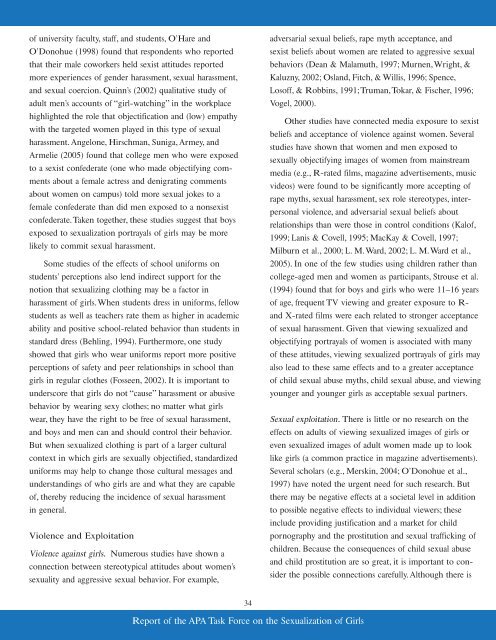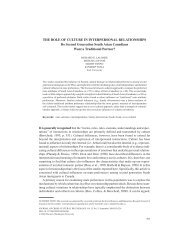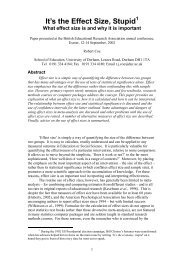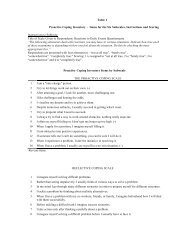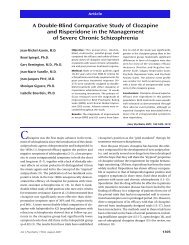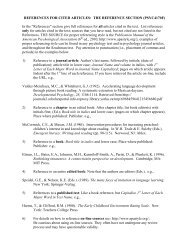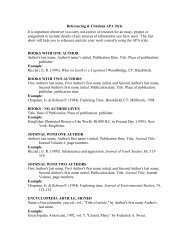SexualizationofWomen.. - Department of Psychology - York University
SexualizationofWomen.. - Department of Psychology - York University
SexualizationofWomen.. - Department of Psychology - York University
Create successful ePaper yourself
Turn your PDF publications into a flip-book with our unique Google optimized e-Paper software.
<strong>of</strong> university faculty, staff, and students, O’Hare and<br />
O’Donohue (1998) found that respondents who reported<br />
that their male coworkers held sexist attitudes reported<br />
more experiences <strong>of</strong> gender harassment, sexual harassment,<br />
and sexual coercion. Quinn’s (2002) qualitative study <strong>of</strong><br />
adult men’s accounts <strong>of</strong> “girl-watching” in the workplace<br />
highlighted the role that objectification and (low) empathy<br />
with the targeted women played in this type <strong>of</strong> sexual<br />
harassment. Angelone, Hirschman, Suniga, Armey, and<br />
Armelie (2005) found that college men who were exposed<br />
to a sexist confederate (one who made objectifying com-<br />
ments about a female actress and denigrating comments<br />
about women on campus) told more sexual jokes to a<br />
female confederate than did men exposed to a nonsexist<br />
confederate.Taken together, these studies suggest that boys<br />
exposed to sexualization portrayals <strong>of</strong> girls may be more<br />
likely to commit sexual harassment.<br />
Some studies <strong>of</strong> the effects <strong>of</strong> school uniforms on<br />
students’ perceptions also lend indirect support for the<br />
notion that sexualizing clothing may be a factor in<br />
harassment <strong>of</strong> girls.When students dress in uniforms, fellow<br />
students as well as teachers rate them as higher in academic<br />
ability and positive school-related behavior than students in<br />
standard dress (Behling, 1994). Furthermore, one study<br />
showed that girls who wear uniforms report more positive<br />
perceptions <strong>of</strong> safety and peer relationships in school than<br />
girls in regular clothes (Fosseen, 2002). It is important to<br />
underscore that girls do not “cause” harassment or abusive<br />
behavior by wearing sexy clothes; no matter what girls<br />
wear, they have the right to be free <strong>of</strong> sexual harassment,<br />
and boys and men can and should control their behavior.<br />
But when sexualized clothing is part <strong>of</strong> a larger cultural<br />
context in which girls are sexually objectified, standardized<br />
uniforms may help to change those cultural messages and<br />
understandings <strong>of</strong> who girls are and what they are capable<br />
<strong>of</strong>, thereby reducing the incidence <strong>of</strong> sexual harassment<br />
in general.<br />
Violence and Exploitation<br />
Violence against girls. Numerous studies have shown a<br />
connection between stereotypical attitudes about women’s<br />
sexuality and aggressive sexual behavior. For example,<br />
34<br />
adversarial sexual beliefs, rape myth acceptance, and<br />
sexist beliefs about women are related to aggressive sexual<br />
behaviors (Dean & Malamuth, 1997; Murnen,Wright, &<br />
Kaluzny, 2002; Osland, Fitch, & Willis, 1996; Spence,<br />
Los<strong>of</strong>f, & Robbins, 1991;Truman,Tokar, & Fischer, 1996;<br />
Vogel, 2000).<br />
Other studies have connected media exposure to sexist<br />
beliefs and acceptance <strong>of</strong> violence against women. Several<br />
studies have shown that women and men exposed to<br />
sexually objectifying images <strong>of</strong> women from mainstream<br />
media (e.g., R-rated films, magazine advertisements, music<br />
videos) were found to be significantly more accepting <strong>of</strong><br />
rape myths, sexual harassment, sex role stereotypes, inter-<br />
personal violence, and adversarial sexual beliefs about<br />
relationships than were those in control conditions (Kal<strong>of</strong>,<br />
1999; Lanis & Covell, 1995; MacKay & Covell, 1997;<br />
Milburn et al., 2000; L. M.Ward, 2002; L. M.Ward et al.,<br />
2005). In one <strong>of</strong> the few studies using children rather than<br />
college-aged men and women as participants, Strouse et al.<br />
(1994) found that for boys and girls who were 11–16 years<br />
<strong>of</strong> age, frequent TV viewing and greater exposure to R-<br />
and X-rated films were each related to stronger acceptance<br />
<strong>of</strong> sexual harassment. Given that viewing sexualized and<br />
objectifying portrayals <strong>of</strong> women is associated with many<br />
<strong>of</strong> these attitudes, viewing sexualized portrayals <strong>of</strong> girls may<br />
also lead to these same effects and to a greater acceptance<br />
<strong>of</strong> child sexual abuse myths, child sexual abuse, and viewing<br />
younger and younger girls as acceptable sexual partners.<br />
Sexual exploitation. There is little or no research on the<br />
effects on adults <strong>of</strong> viewing sexualized images <strong>of</strong> girls or<br />
even sexualized images <strong>of</strong> adult women made up to look<br />
like girls (a common practice in magazine advertisements).<br />
Several scholars (e.g., Merskin, 2004; O’Donohue et al.,<br />
1997) have noted the urgent need for such research. But<br />
there may be negative effects at a societal level in addition<br />
to possible negative effects to individual viewers; these<br />
include providing justification and a market for child<br />
Report <strong>of</strong> the APA Task Force on the Sexualization <strong>of</strong> Girls<br />
pornography and the prostitution and sexual trafficking <strong>of</strong><br />
children. Because the consequences <strong>of</strong> child sexual abuse<br />
and child prostitution are so great, it is important to con-<br />
sider the possible connections carefully. Although there is


